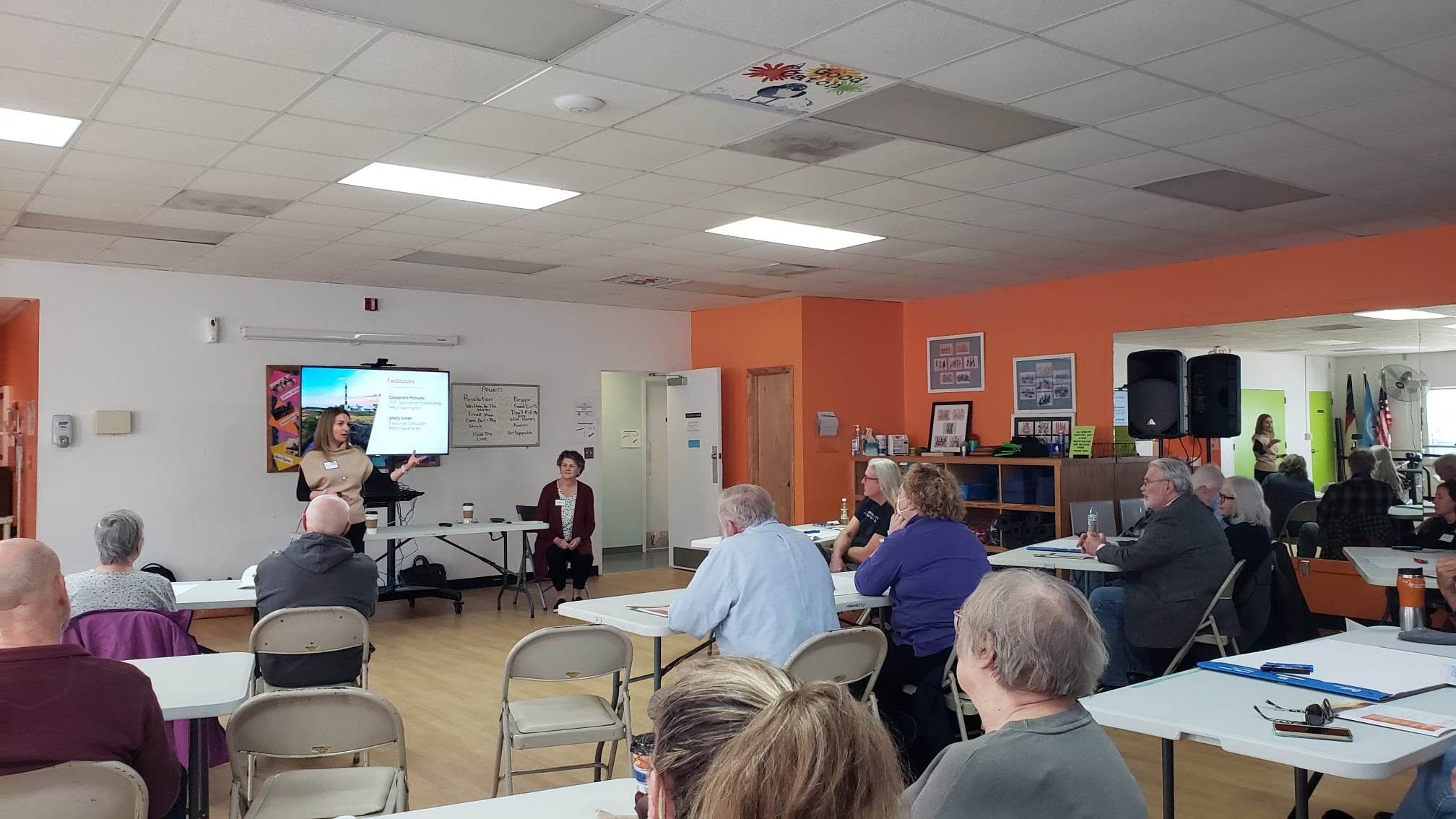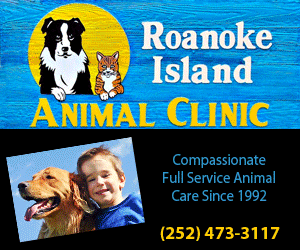
Roughly 30 Hatteras Islanders attended a Tuesday meeting hosted by the Outer Banks Visitors Bureau (OBVB) that aimed to gather feedback and insight for an upcoming Long-Range Tourism Management Plan.
The plan, (which is in the stakeholder engagement phase), will help guide future tourism-related growth and development in Dare County for years to come.
The project stems from a collaboration with MMGY NextFactor, a consulting firm specializing in travel and tourism, and the company has been spending the last few months conducting interviews, meeting with local leaders, and soliciting input from the Outer Banks public at large.
“The Tourism Board wants to be more intentional about hearing from the community and making sure that the things that we do with tourism in the long term include the community. It’s not sustainable for the largest industry in the county to be at odds with the residents,” said Lee Nettles, OBVB Executive Director. “Community involvement is essential for long-term sustainable growth, and I think the participation we’ve seen is a step in that direction.”
“It says to me that the community recognizes what we’re trying to do, and wants to be involved.”
The Fall 2022 Survey
As MMGY Senior Vice President Cassandra McAuley noted at the meeting, the response from Outer Banks residents and stakeholders has been enthusiastic so far. In the fall of 2022, an online survey associated with the project garnered more than 4,500 responses from Outer Banks residents and property owners. “When we did a similar resident survey in Los Angeles, we only received 1,000 responses, so this is phenomenal,” she said.
The survey was available from October 24 through November 28, 2022, and 62% of the respondents were full-time residents, with the majority of residents living on Outer Banks for 10 years or more. 75% of the participants in the survey were also at least 50 years old or older.
The extensive survey dived into questions about whether residents enjoyed living on the Outer Banks, what the best features were for residents and visitors, and what the challenges were in regard to the region’s growing tourism industry.
Visitation to the Outer Banks peaked during the Coronavirus pandemic, with more than 3,200,000 visitors to the Cape Hatteras National Seashore alone in 2021. (This number was roughly 20% higher than 2020, and more than 35% higher than the ten-year visitation average from 2011-2020.)
While visitation noticeably tapered off in 2022, the majority of survey respondents said that tourism had a big impact on their family and community, and that protecting the area’s beaches and natural resources were a high priority.
Other big challenges that were identified in the survey results included an increase in traffic issues, and a critical shortage of housing, and these themes were prevalent at the January 24 meeting as well.
The January 24 Meeting
The purpose of the Buxton meeting was similar to the survey, as it was an opportunity for the OBVB and MMGY NextFactor to solicit input from the community on these tourism-related questions and more.
Digging into the details of what makes the Outer Banks stand out as a tourism destination, (as well as the current and future issues that were connected to an influx in visitors), the meeting’s two-hour comment period generated a lot of discussion from attendees, who were a mix of business owners, employees, and folks who weren’t necessarily employed in a tourism-related field.
The public discussion included a series of questions that attendees were asked to answer, (which are listed below).
Early on in the discussion, however, one resident pointed out that when it came to the Outer Banks, Hatteras Island was considered its own entity by the folks who lived there.
“As I read these questions – like ‘What makes the Outer Banks different?’- I interpret that as referring to Hatteras Island, and not all of Dare County” said the resident. “This place is magic. This is a magical island… So when I see ‘Outer Banks,’ I’m thinking Hatteras Island, which is very different from the rest of the [county].”
The comment was agreed on by the crowd, and McAuley, (who served as the facilitator for the ensuing discussion), said that this was why the Buxton meeting was held. “That’s an excellent point, and that’s why we’re here today, as opposed to just having a couple of sessions up the beach.”
After the presentation on the 2022 survey results, the meeting attendees were asked the following questions:

What makes the Outer Banks a great place to live and visit?
The attendees’ answers to this question mainly focused on two attributes: the natural and undeveloped environment, and the inherent sense of heritage and community.
“What [sets us apart] is the extent to which we all come together for the greater good,” said Hatteras resident Ernie Foster. “It’s just outstanding.”
What would make the Outer Banks an even better place to live, work, and visit?
There were a few common answers to this question as well, which included a recycling program, better traffic flow, better transportation and the installation of bike paths, and better infrastructure which included the Hatteras Island Rescue Squad, the local volunteer fire departments, and medical facilities. Beach nourishment was also mentioned, particularly for Rodanthe, as well as an adjustment to wages.
The biggest and most prevalent answer, however, was housing. Real estate prices reached record highs in 2022 along the Outer Banks, and with an increase in Airbnbs and privately-rented vacation homes, year-round housing has become increasingly scarce.
“The monster in the room [is] the housing issue,” said resident Kitty Oden. “I know some of the people in this room are business owners, and you can’t find people to work for you, because if you bring them in from elsewhere, they have nowhere to live…”
“There’s no place for people that want to come and work here. So what are we doing, and what can we do?”
What could be created in the Outer Banks that would lead to a better experience for residents?
The meeting attendees had a wide range of answers to this question, which ranged from broad responses like trying to identify more creative solutions, to specific plans such as putting in a turn lane near the campgrounds in the Tri-villages, where traffic can get heavily congested on summer weekends.
The bigger issues – like the affordable housing shortage, the need for more medical centers and community infrastructure, and the growing impacts of erosion – did not have obvious answers.
But as resident Jeffrey Del Monte pointed out, the majority of vacation destinations around the country had similar issues, and when it came to attracting and keeping visitors, a positive message was key.
“We need to be careful in the message as residents as business owners,” said Del Monte. “Yes, tourism is up. There will be waits in restaurants. There is congestion on the streets. But I think all of us have a duty to let people know we’re worth the drive, and we’re worth the wait. We need to protect the fact that people still choose to come here. Generations of families are still coming, and that’s something we’re all responsible for.”
What’s next
A second meeting was held in Kill Devil Hills on Tuesday evening, with approximately 100 attendees, per Sam Walker of wobx.com.
Using the feedback from Tuesday’s meetings, as well as other public forums and the 4,500 survey results, the MMGY NextFactor team will create a final report for the OBVB, which is expected in the spring of 2023.
Per the OBVB’s details on the project, the resulting report will:
- Create a clearly defined long-term vision for Dare County’s visitor economy, to which the community and stakeholders are committed, with an agreed understanding of what success looks like.
- Identify opportunities to develop and/or enhance visitor experiences that meet the visitors’ expectations while maintaining authenticity to the destination brand.
- Identify areas of need that require management for proactive mitigation planning.
- Prioritize actions for achieving the long-term vision that are realistic and achievable.
- Build stronger alignment between the visitor economy, economic development, and community well-being through a collaborative process.
- Identify the tools necessary to guide the management of tourism impacts on the environment, transportation, infrastructure, local culture and heritage, and the economy.
“We’re a small community, and every one in three people is employed in travel and tourism-related jobs in Dare County, so there’s always been a connection, but I think that the Tourism Board wants to be more intentional about hearing from the community, and making sure that the things we do with tourism in the long-term include the community’s input,” said Nettles.
“The cool thing about the Outer Banks is that we’re a small enough community that if we can figure out what we need to do, we can actually come together and [accomplish it.] We have millions of guests, but we’re 37,000 people spread out across 100 miles, and that’s one of our greatest strengths.”
Nettles noted that the results from the community will be helpful for the Tourism Board, but it will also spiderweb to the other stakeholders and leaders in the county, hopefully leading to new initiatives and changes across the board.
“It should help to inform the investments of the Tourism Board, certainly, but hopefully, [it will help] the coordination of the different towns and the county as well. Because I think if we’re talking about things like housing and infrastructure, that’s going to take all of us paddling in the same direction,” said Nettles. “That’s part of it, but I also think part of this process is just closing the gap between residents and the tourism industry, and hopefully getting us more in the same place so that tourism doesn’t feel like it’s something that’s happening to you, it’s happening with you.”
“We have like a special opportunity right now to reshape how we go about doing tourism business, and hopefully, direct it a little bit more positively.”









